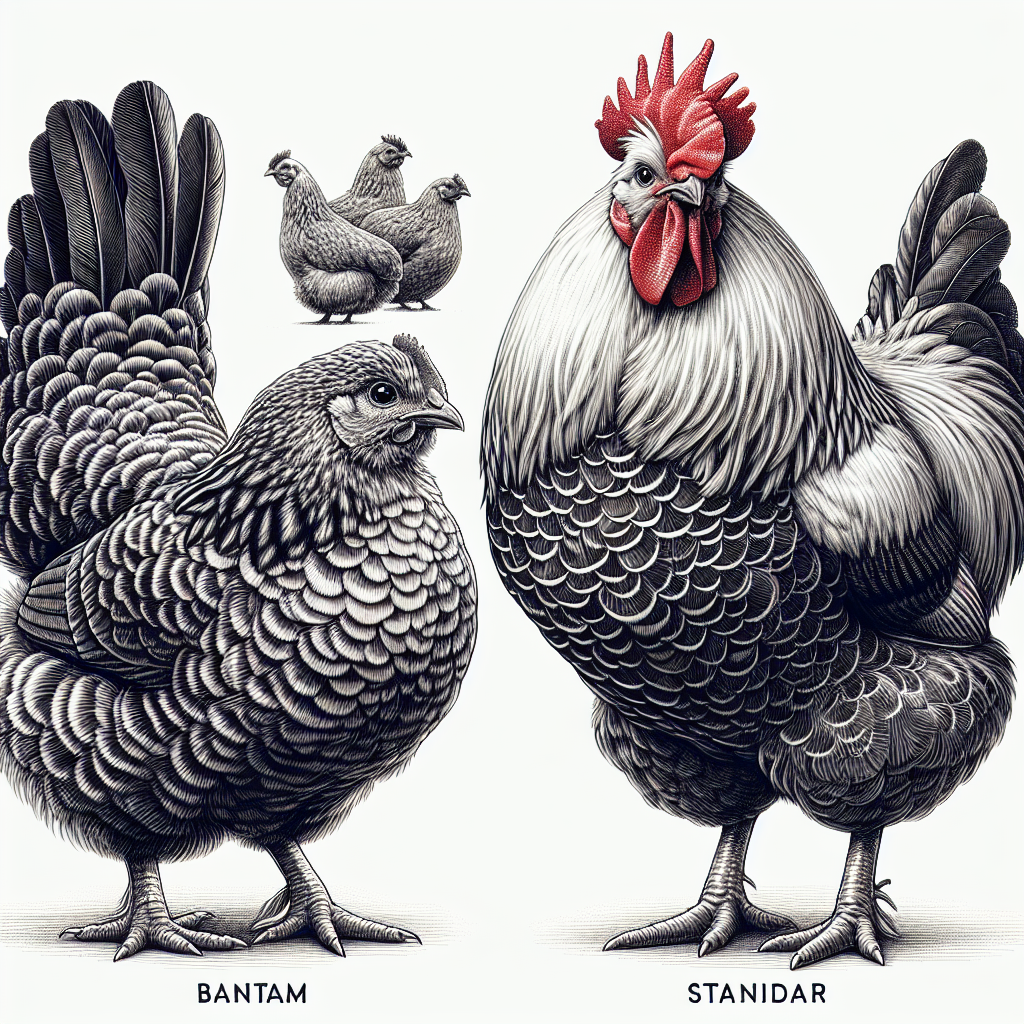Imagine the excitement and anticipation of combining two flocks of birds together. As a bird enthusiast, you’ve decided to merge these two groups, but now you face an intriguing challenge: how do you manage the social dynamics between these feathered friends? With different personalities, behaviors, and hierarchies at play, understanding how to navigate this delicate process is crucial. In this article, we will explore effective strategies to help you successfully merge two flocks of birds, ensuring a harmonious and thriving environment for all involved. So, let’s embark on this fascinating journey of merging flocks and discover the key to maintaining social harmony among our avian companions.
Establishing a Coop Hierarchy
Observing the Existing Hierarchy in Each Flock
When merging two flocks, it’s important to take the time to observe and understand the existing hierarchy within each flock. Chickens naturally establish a pecking order, with dominant individuals asserting their authority over others. By carefully observing the interactions between flock members, you can gain valuable insights into their social dynamics and determine how best to integrate them.
Introducing New Members Gradually
To minimize the potential for conflict and establish a harmonious coop hierarchy, it’s crucial to introduce new members gradually. Suddenly introducing new birds can be stressful for both the newcomers and the existing flock members. Instead, consider using a separate enclosure adjacent to the main coop for a period of time, allowing the two flocks to become accustomed to each other’s presence without direct contact.
Identifying Potential Conflicts
During the gradual introduction process, keep a close eye on the interactions between the two flocks. Look for any signs of aggression or bullying, such as excessive pecking or chasing. Identifying potential conflicts early on allows you to intervene and address the issue promptly, ensuring the safety and well-being of all your feathered friends.
Encouraging Pecking Order Establishment
Establishing a new pecking order is a natural part of integrating two flocks. It’s important to allow the birds to assert their social hierarchy through non-violent means. As long as the interactions are not excessively aggressive or causing harm, it’s generally best to let the chickens work out their own hierarchy. By allowing them the freedom to establish their ranking, you’re promoting a more stable and balanced social dynamic within the merged flock.
Monitoring and Intervening if Necessary
Throughout the process of merging the two flocks, it’s crucial to be vigilant and monitor their interactions closely. While it’s ideal to allow the chickens to resolve conflicts on their own, there may be instances where intervention is necessary. If you notice prolonged and severe aggression, it’s important to separate the involved birds to prevent injuries. By maintaining a watchful eye, you can ensure a smooth transition and the establishment of a cooperative and harmonious coop hierarchy.
Creating a Neutral Territory
Selecting a Suitable Location
Before introducing the two flocks, it’s important to create a neutral territory where they can interact without feeling territorial. This area should be separate from the main coop and provide enough space for the birds to move around comfortably. Choose a location away from the main flock’s feeding and nesting areas to reduce potential conflict over resources.
Preparing the Neutral Territory
Creating a suitable neutral territory involves preparing it to ensure the comfort and safety of the chickens. It should have secure fencing to prevent any accidental escapes or unwanted intrusions from predators. Additionally, provide adequate shelter, such as a coop or temporary structure, to shield the birds from harsh weather conditions.
Providing Adequate Resources
To minimize resource competition and potential conflicts, make sure the neutral territory has sufficient resources for all the birds. This includes multiple feeders and water sources strategically placed to prevent overcrowding and allow access for all flock members. Adequate nesting spots should also be provided to ensure each bird has a comfortable place to lay eggs and rest.
Monitoring Initial Interactions
Once the neutral territory is prepared and the two flocks are brought together, it’s important to closely monitor their initial interactions. Pay attention to how they behave around the shared resources and observe any signs of aggression. Being present during this stage allows you to intervene if necessary and ensure a smooth integration process.
Managing Introductions
Using Temporary Dividers
When merging two flocks, it can be beneficial to initially separate them using temporary dividers. This allows the birds to see each other without direct physical contact, reducing the chances of aggressive behavior. The dividers can be gradually adjusted or removed as the birds become more acclimated to each other’s presence.
Allowing Visual Contact
After using temporary dividers, it’s important to gradually allow the birds visual contact with each other. This can be done by removing the dividers or providing mesh fencing that allows them to see and observe one another. Visual contact helps the chickens become familiar with each other’s appearance and body language, which is an important step in the integration process.
Supervised Direct Interactions
Once the chickens have had time to adjust to visual contact, you can cautiously progress to supervised direct interactions. Allow them to interact under your watchful eye, paying close attention to their body language and behavior. This stage helps the chickens establish social bonds and get used to each other’s presence in a controlled and supervised environment.
Assessing Body Language and Behavior
When managing the introductions, it’s crucial to assess the body language and behavior of the chickens. Signs of aggression, such as fluffing up feathers, lunging, or excessive pecking, should be addressed promptly. Conversely, positive signs of integration, such as gentle interactions and mutual grooming, should be encouraged and reinforced.
Separating Aggressive Individuals
In the event that you notice persistent or escalating aggression during the introductions, it’s essential to separate the aggressive individuals. This prevents injuries and allows for a safer and smoother integration process. Isolate the aggressive birds in a separate area until they have calmed down. Only reintroduce them when they can interact without aggressive behavior.
Avoiding Resource Competition
Providing Multiple Feeders and Water Sources
One of the main causes of conflict between merged flocks is resource competition, particularly over feeders and water sources. To avoid this, ensure there are multiple feeders and water sources available for all the birds. Space them out to minimize crowding and allow easy access for every member of the flock.
Ensuring Sufficient Nesting Spots
Nesting spots are another important resource that can lead to conflict if there are not enough for all the chickens. Make sure there are sufficient nesting spots in the coop and provide alternative options such as separate nesting boxes or secluded areas where hens can comfortably lay their eggs. This promotes a sense of security and reduces the likelihood of aggression.
Incorporating Environmental Enrichments
Introducing environmental enrichments in the coop can help divert the chickens’ attention away from potential resource competition. Provide items such as hanging treats, perches, or toys that encourage natural behavior and engage their curiosity. These enrichments provide mental stimulation and can help alleviate stress, reducing the chances of aggression.
Avoiding Overcrowded Spaces
Overcrowding can lead to increased competition for resources and heightened stress levels among the chickens. To maintain a harmonious flock, ensure there is enough space for all the birds to move around comfortably. Provide an adequate square footage per bird in both the coop and outdoor areas to minimize overcrowding and promote peaceful coexistence.
Maintaining a Balanced Diet
Observe Feeding Behavior
Observing the feeding behavior of your chickens is essential for maintaining a balanced diet. Ensure that all flock members have equal opportunities to access the food and observe if any birds are being excessively dominant or preventing others from eating. If you notice any imbalances or concerns, it may be necessary to adjust feeding strategies accordingly.
Ensure Sufficient Access to Food
To prevent resource competition and potential aggression, make sure there is sufficient access to food for all the birds in the merged flock. This can be achieved by providing multiple feeders or scattering the feed across a larger area. Ensuring that each chicken has easy access to a balanced diet helps maintain their overall health and reduces the risk of aggression caused by hunger or frustration.
Monitor Weight and Health
Regularly monitoring the weight and overall health of your birds is crucial to ensure they are receiving a balanced diet. Keep an eye out for any sudden weight loss or gain, as this may indicate an imbalance in their food intake. Additionally, observe their overall behavior, feather quality, and egg production to identify any signs of nutritional deficiencies or health issues.
Offering Treats as Distractions
Introducing treats into the chickens’ diet can serve as a distraction and help redirect their attention away from potential conflicts. Treats, such as vegetables or mealworms, can be used during periods of integration or coop hierarchy establishment to promote positive interactions and reduce stress. However, it’s important to provide treats in moderation and as part of a balanced diet.
Minimizing Stress and Anxiety
Maintaining Consistent Daily Routine
Chickens thrive on routine, and sudden disruptions in their daily schedule can cause stress and anxiety. When merging two flocks, try to maintain a consistent daily routine in terms of feeding, watering, and letting the birds out to free-range. Keeping their schedule predictable helps alleviate stress and provides a sense of stability, contributing to a smoother integration process.
Introducing New Flocks During Calm Periods
Timing is crucial when merging flocks to minimize stress and anxiety. It’s best to introduce new flocks during calm periods, avoiding times of extreme weather or other significant changes. This reduces the overall stress on both the existing flock and the newcomers, helping them adjust and integrate more easily.
Reducing Noise and Distractions
Excessive noise and distractions can heighten stress levels among chickens. When merging two flocks, try to minimize or eliminate sources of loud noises or disturbances, such as construction work or loud machinery. Reducing these disruptions creates a more peaceful environment, allowing the birds to focus on social interactions and adjustment.
Providing Sheltered Areas
Offering sheltered areas within the coop and outdoor space provides chickens with a sense of security. These sheltered areas, such as covered perches or hiding spots, allow the birds to retreat and rest when they feel overwhelmed or stressed. By providing these safe havens, you create a more calming environment that supports their overall well-being.
Monitoring and Recognizing Aggression
Understanding Normal Pecking Behavior
Pecking is a natural and necessary behavior in chickens. It’s their way of establishing hierarchy and maintaining social order. However, it’s important to differentiate between normal pecking and excessive aggression. Normal pecking involves brief pecks and occasional chasing, while aggression manifests as relentless pursuit, injury, or excessive feather plucking.
Identifying Signs of Aggression and Bullying
It’s crucial to be able to identify the signs of aggression and bullying during the integration process. These signs may include excessive pecking, chasing, feather loss, injuries, or extreme distress in certain individuals. By closely monitoring your flock, you can promptly recognize and address any aggressive behavior to ensure the safety and well-being of all the birds.
Addressing Aggression Promptly
If you notice any signs of aggression, it’s important to address the issue promptly to prevent further harm. Depending on the severity of the aggression, you may need to separate the birds involved and reintroduce them at a later stage. Distracting aggressive birds with treats or rearranging the coop layout can also help redirect their attention and diffuse tension.
Isolating Aggressive Birds if Required
In some cases, aggression may persist despite intervention attempts. If an individual bird continues to exhibit aggressive behavior, it may be necessary to isolate them from the flock temporarily. This allows the aggressive bird to calm down and prevents harm to the rest of the flock. Gradual reintroduction can be attempted once the bird has shown signs of improved behavior.
Integrating the Flocks Gradually
Allowing Short Periods of Physical Interaction
As the integration process progresses, it’s important to allow short periods of physical interaction between the two flocks. This can be done by supervised free-ranging sessions where the flocks are allowed to mingle but with restricted time initially. Gradually increasing the duration of these interactions promotes social bonding and helps pave the way for full integration.
Continuing Supervised Interactions
Even as the flocks start to integrate more extensively, it’s crucial to maintain supervised interactions, especially during feeding or other potentially contentious situations. Pay close attention to any signs of aggression or resource competition, and intervene if necessary to avoid escalating conflicts. Regular supervision ensures a smooth and safe integration process.
Monitoring Behavior During Longer Intervals
As the integration progresses and the flocks spend longer periods together, it’s important to continue monitoring their behavior. Observe how they interact during extended free-ranging sessions and coop time. Take note of any changes in their behavior or new signs of aggression. Ongoing monitoring allows for early identification and intervention before conflicts escalate.
Implementing Full Integration
After a gradual and successful integration process, the merged flocks can be fully integrated. At this stage, the chickens should be able to coexist harmoniously and share resources without conflict. It’s important to keep observing their interactions to ensure a stable hierarchy and address any emerging issues promptly. Ultimately, achieving a fully integrated flock is a testament to your successful management of social dynamics.
Understanding Individual Needs
Consider Age and Size Differences
When merging two flocks, it’s essential to consider the age and size differences among the birds. Younger or smaller chickens may be more vulnerable to aggression from older or larger ones. Take this into account during the integration process and provide adequate protection and support for the more vulnerable individuals until they can establish their place within the flock.
Accommodate for Unique Requirements
Each chicken is unique and may have specific requirements or preferences. Some birds may have dietary restrictions or health conditions that require special attention. When merging flocks, accommodate for these individual needs by ensuring proper access to appropriate food, water, and healthcare. Recognizing and meeting these unique requirements contributes to the overall well-being of the merged flock.
Separate Vulnerable or Special Needs Birds
In certain cases, it may be necessary to separate vulnerable or special needs birds from the rest of the flock. This could include injured or sick chickens, molting birds, or those with specific behavioral issues. Isolating these individuals in a separate area provides them with the necessary care and reduces the risk of further harm or stress caused by the integration process.
Providing Individualized Care
Throughout the integration process and beyond, it’s important to provide individualized care for the chickens in the merged flock. This could involve monitoring each bird’s health, ensuring access to appropriate feed, water, and shelter, and addressing any specific needs or concerns. By meeting the individual requirements of each chicken, you create a supportive and nurturing environment for the entire flock.
Seeking Professional Advice
Contacting Local Poultry Experts
If you encounter challenges or have specific concerns during the flock merging process, reaching out to local poultry experts can provide valuable guidance and support. They have extensive knowledge and experience in managing social dynamics among chickens and can offer tailored advice based on your specific situation.
Consulting a Veterinarian
A veterinarian specializing in poultry can provide professional advice on various aspects of merging flocks, including health concerns and dietary requirements. They can conduct health checks and recommend any necessary vaccinations or treatments to ensure the well-being of the merged flock. Consulting a veterinarian can help address any potential health issues that may arise during the integration process.
Joining Online Poultry Communities
Online poultry communities, such as forums or social media groups, provide a platform for connecting with fellow chicken enthusiasts and experts. Joining these communities allows you to share experiences, seek advice, and learn from the knowledge and wisdom of others who have successfully merged flocks before. It’s a great way to expand your knowledge and receive support from like-minded individuals.
Attending Workshops or Seminars
Workshops or seminars focused on backyard chicken keeping and flock management can be a valuable resource for learning about the intricacies of merging flocks. These events often feature experts who provide insights, practical tips, and demonstrations on managing social dynamics. Attending such workshops allows you to deepen your understanding and gain confidence in successfully merging and managing your own flocks.
In conclusion, merging two flocks of chickens requires thoughtful and careful management of social dynamics. By establishing a coop hierarchy, creating a neutral territory, managing introductions, minimizing resource competition, maintaining a balanced diet, minimizing stress and anxiety, monitoring aggression, integrating flocks gradually, understanding individual needs, and seeking professional advice, you can ensure a smooth and successful integration process. With patience, observation, and intervention when necessary, you will foster a cooperative and harmonious environment for your merged flock to thrive.




